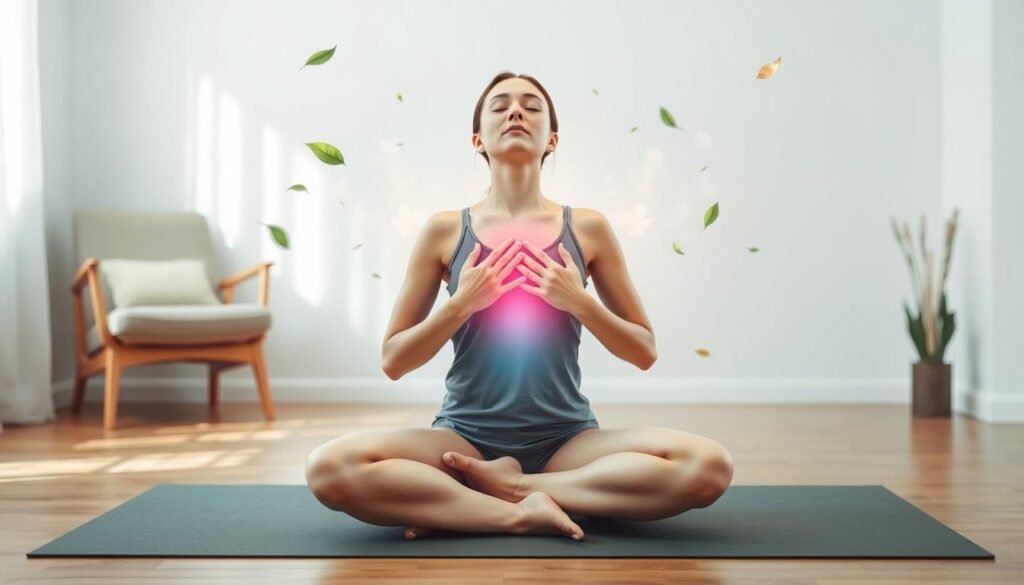Did you know we usually take 10 to 20 breaths a minute? Experts say slowing down to 4 to 10 breaths can help relax us. This big change is key in handling anxiety. Deep breathing exercises turn on the body’s calm system. Techniques like diaphragmatic and resonant breathing are easy to do anywhere. They are great for people looking for anxiety relief techniques.
Learning to breathe deeply helps calm anxiety. Studies show these exercises lower stress and make us feel better overall. By practicing deep breathing, you’ll learn how simple breaths can change the way you deal with anxiety.
Key Takeaways
- Slowing breath rates can significantly reduce anxiety and promote relaxation.
- Deep breathing exercises help activate the body’s relaxation response, improving overall well-being.
- Techniques like diaphragmatic and resonance breathing effectively alleviate stress symptoms.
- Practicing tailored breathing can stimulate the vagus nerve and lower heart rate.
- Mindful breathing can enhance mental clarity and emotional stability.
Understanding Anxiety and Its Effects on Breathing
Anxiety affects our minds and bodies. It can change how we breathe. People with anxiety often breathe too fast. This can make them feel out of breath. Understanding physiological effects of anxiety helps in dealing with it.
The body might start breathing fast as a defense mechanism. This can make anxiety worse. Breathing techniques for anxiety help bring back peace and stability.
Anxiety is a common mental health issue worldwide. It deeply impacts overall health. Sadly, lots of people don’t get the help they need. Only a few get the right medications or counseling.
Breathing methods are now seen as helpful for anxiety. They work by slowing down breaths. Diaphragmatic breathing, for instance, can improve heart health and reduce anxiety. With time, anxiety and deep breathing exercises build defense against anxiety.
| Study Characteristics | Effective Interventions | Ineffective Interventions |
|---|---|---|
| Human-guided training | 54 out of 72 interventions | Extensive standing |
| Multiple sessions | Focus on slow and controlled breathing | Interruptions during sessions |
| Long-term practice (6+ sessions over a week) | Improved management of anxiety symptoms | Inadequate training for highly technical practices |
Benefits of Deep Breathing Exercises for Anxiety Relief
Deep breathing exercises help people find relief from anxiety. They lower the heart rate and blood pressure, making the body relaxed. This makes it easier to handle anxiety symptoms. These exercises focus on controlled breathing, taking the mind off worrying thoughts.
Deep breathing can improve your mood and make you feel better overall. It involves paying attention to your breath, which keeps you in the present. This helps shift from shallow to deep breathing, reducing anxiety. With time, deep breathing can lessen headaches and migraines, and bring deep relaxation.
Adding deep breathing to your daily life can have lasting benefits. It’s a strong way to fight stress and boost mental health.
| Aspect | Young Adults | Older Adults |
|---|---|---|
| Mean Age | 19.56 years | 65.86 years |
| Male Percentage | 16.0% | 22.7% |
| Anxiety Score | 7.92 | 6.41 |
| Average Sleep Hours | 7.44 | 7.50 |
| Mean Sleep Quality Score | 5.53 | 6.60 |
How to Practice Deep Breathing for People with Anxiety
To start practicing deep breathing for anxiety, it’s key to know your triggers. Many people find stress in deadlines or being in crowded areas. When we know what makes us anxious, we can find better ways to relax. Knowing what triggers your anxiety helps you manage your reactions. It also prepares you for deep breathing techniques.
Identifying Triggers for Anxiety
Knowing what sets off your anxiety is critical when practicing calming breath techniques. Common triggers include:
- Work-related stress
- Social interactions
- Financial concerns
- Health-related worries
Understanding these triggers allows you to tackle anxiety better. This understanding helps you use relaxation techniques more effectively.
Setting Up a Calming Environment
Having a peaceful place helps a lot with breathing exercises. To make your space calming, you can:
- Adjust lighting to softer tones
- Reduce ambient noise
- Use scents like lavender or chamomile
- Find a comfortable seating position
Just a few minutes to create this environment can deepen your focus. Doing breathing exercises here can greatly reduce anxiety. For more ways to practice deep breathing, visit this helpful site.

Various Deep Breathing Techniques
Deep breathing is a powerful tool for fighting anxiety. It offers several methods, each with its own benefits. This means people can choose what works best for them. Using these techniques often can improve emotional control and bring peace.
Diaphragmatic Breathing
Diaphragmatic breathing engages the diaphragm for deeper breaths. It helps the body unwind, easing the tension anxiety causes. Making it part of your daily life can lead to a slower heart rate and lower blood pressure. This helps enhance overall health.
Resonant Breathing
Resonant breathing aims for a balanced breath pace. You breathe in and out for the same amount of time. This pattern brings calmness and lowers stress levels. Doing resonant breathing often can greatly decrease anxiety symptoms. It’s an excellent tool for mental health. For more info, check out effective breathing exercises.
Abdomen Breathing
Abdomen breathing focuses on the stomach’s movement. This awareness boosts mindfulness and diverts from stress. It clears the mind and relaxes you. It’s a helpful way to handle anxiety and ease tension.
| Technique | Benefits |
|---|---|
| Diaphragmatic Breathing | Engages diaphragm; lowers heart rate; promotes relaxation. |
| Resonant Breathing | Creates rhythm; reduces stress; enhances emotional balance. |
| Abdomen Breathing | Promotes mindfulness; clears mind; reduces physical tension. |
Mindfulness Breathing Techniques
Practicing mindfulness breathing techniques can help lower anxiety and connect deeper with one’s breathing. These strategies encourage focusing on breath while staying aware of thoughts and feelings without judgment. This awareness brings calmness, reducing stress from daily life.
The 4-7-8 breathing exercise is a favorite among many. It begins with three cycles and can extend to five to ten minutes. This routine enhances relaxation and mental clarity. Then there’s diaphragmatic breathing, or belly breathing, done for twenty to thirty minutes daily to decrease stress significantly.
For those with anxiety tied to breathing issues, pursed-lip breathing is helpful. It consists of inhaling slowly through the nose for two seconds and exhaling through puckered lips for four seconds. This creates a calming rhythm that aids in mindfulness.
Resonance breathing is another method that combines mindfulness with breathing. You inhale and exhale for six seconds each. This approach promotes a serene state and focuses on bodily sensations. Doing this breathing exercise helps with relaxation and managing emotions.

The lion’s breath technique is great for stress relief too. It involves deep inhalations followed by a strong exhale, similar to a lion’s roar. Doing this up to seven times can relax and empower you.
Trying out mindfulness breathing techniques offers important benefits for those dealing with anxiety. By sticking to these exercises, you can improve your emotional health. You’ll also be better equipped to tackle life’s challenges more smoothly.
Calming Breathwork for Anxiety
Calming breathwork is a strong way to handle anxiety. Adding focused breath techniques to your day helps you learn how to breathe on purpose. This promotes relaxation. Techniques include counting breaths or saying mantras while breathing out. Also, using visualization can make breathing exercises more helpful.
By imagining calming scenes, like quiet forests or calm rivers, while you breathe deep. This link between calming images and deep breaths enriches the calming experience.
Focused Breath Techniques
Using focused breathing methods can lower anxiety a lot. The 4-7-8 exercise is one good way to do this. You breathe in for 4 seconds, hold it for 7, then slowly breathe out for 8 seconds. This helps relax and reduce stress. By doing this every day for 5 to 20 minutes, you can really feel calmer.
Some people do this twice a day. They find they feel more peaceful and sleep better too.
Visualizing Calmness During Breathing
Thinking of peaceful places while doing breath exercises can boost their calming effects. While taking deep breaths, imagine being in a place that’s really calm, like a quiet beach or a gentle stream. This mental picture makes the act of breathing even more calming.
Studies show that this technique really works. It lowers feelings of anxiety and stress (source). Regular practice of visualization with focused breathing is a great way to deal with anxiety.

Practicing Equal Breathing for Balance
Equal breathing is a method that balances your breath. It makes you inhale and exhale for the same time. It promotes calm and steadiness. You can do this technique in any comfortable position. It can make you feel calmer and manage stress better.
Breathing exercises like this one bring many benefits. They can make you happier and less anxious. People feel better emotionally after using them. This technique lowers the stress hormone, cortisol. It helps you feel more at ease every day.
Try making equal breathing part of your daily life. Here’s a simple way to start:
- Find a quiet space to sit comfortably or lie down.
- Inhale slowly through the nose for a count of four.
- Hold the breath for a count of four.
- Exhale gently through the mouth for a count of four.
- Pause for another count of four before inhaling again.
This cycle creates a steady breathing rhythm. It grounds you and reduces anxiety. Equal breathing can be combined with other methods to improve wellness. For more tips on breathing exercises, visit this resource.
Using Yoga and Breathing Together
Yoga and breathing work together to help manage anxiety. They make relaxation deeper and increase mindfulness. With practices like lion’s breath and alternate nostril breathing, stress can be reduced, and well-being can improve.
Lion’s Breath
Lion’s breath helps let go of tension and energy. You do this by exhaling forcefully, sticking out your tongue, and opening your eyes wide. It helps reduce anxiety and boosts courage. Adding it to yoga routines can help settle the mind, even when things feel chaotic.
Alternate Nostril Breathing
Alternate nostril breathing brings calm and balance. It works by breathing through one nostril at a time. This can help lower anxiety and improve focus and calmness. It’s known for boosting mental clarity and emotional stability.
These breathing methods can deeply impact mental health. For more details on yoga and breathing for anxiety, check out this resource.
Additional Relaxation Techniques to Complement Breathing Exercises
Using relaxation techniques for anxiety with deep breathing exercises can really help. These methods offer a complete way to handle stress. They make you feel better overall. People can try out different ways to find what works best for them. This helps create a peaceful mindset.
Some popular options include:
- Progressive Muscle Relaxation: This method involves tightening and then relaxing various muscle groups to ease tension.
- Guided Imagery: Imagining calm places or situations helps bring about a relaxed state.
- Gentle Stretching: This activity physically engages the body while helping to improve flexibility and relaxation.
- Meditation: This practice focuses on being mindful and aware, which calms the mind and lowers anxiety.
- Aromatherapy: Using essential oils can help relax and alleviate stress.
- Yoga: Yoga blends physical poses with breathing to achieve harmony between mind and body.
Studies show that adding additional techniques to enhance breathwork, like tai chi, is very beneficial. These activities can lower heart rates and blood pressure. They also help digestion and enhance life quality.
| Technique | Benefits | Practice Duration |
|---|---|---|
| Progressive Muscle Relaxation | Lowers muscle stress | 15-30 minutes |
| Guided Imagery | Brings calmness | 10-20 minutes |
| Gentle Stretching | Improves relaxation | 10-15 minutes |
| Aromatherapy | Encourages relaxation | No specific time |
| Yoga | Creates balance | 30-60 minutes |
Combining these techniques with breathing exercises offers a strong strategy against anxiety. With dedication, each person can find the best combination for their needs. This leads to better mental health and peace.
Conclusion
Deep breathing exercises are key for anxiety relief in our busy world. Studies, like one with COVID-19 patients, show they reduce stress. So, people looking to feel better mentally should try deep breathing every day.
To start, know what stresses you and create a peaceful space. Practicing deep breathing techniques regularly builds a strong mental toolkit. This is crucial as chronic stress is a big problem for adults, and deep breathing helps fight it.
Deep breathing does more than ease anxiety in the moment. It builds lasting mental strength. Making these exercises a habit leads to a calmer life. By valuing deep breathing, we can change how we handle stress and improve self-care.